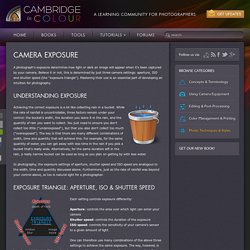

The Complete Digital Photography. Reciprocity Earlier, you learned that a stop is a measure of light. When you double the amount of light that hits the sensor, we say that you have increased the amount of light exposure by one stop. Conversely, if you halve the light, you decrease the exposure by one stop. Consider these shutter speeds: Each one is double (roughly) the previous shutter speed. Now look at this list of apertures: F4 f5.6 f8 f11 f16 f22 Because most of us aren’t familiar with calculating the area of a circle, the relationship between these numbers isn’t so obvious.
When you encounter a situation where you need to balance motion stopping power with depth of field and overall illumination, you can take advantage of the fact that both shutter speed and aperture can be adjusted by the same amount in opposite directions. For example, let’s say your camera recommends an exposure of 1/500th of a second at f8. Reciprocal ISOs Some cameras offer a wider range of ISOs then what you see here.
Fractional Stops Summing Up. Camera-Exposure. A photograph's exposure determines how light or dark an image will appear when it's been captured by your camera.

Believe it or not, this is determined by just three camera settings: aperture, ISO and shutter speed (the "exposure triangle"). Mastering their use is an essential part of developing an intuition for photography. Achieving the correct exposure is a lot like collecting rain in a bucket. While the rate of rainfall is uncontrollable, three factors remain under your control: the bucket's width, the duration you leave it in the rain, and the quantity of rain you want to collect. You just need to ensure you don't collect too little ("underexposed"), but that you also don't collect too much ("overexposed").
In photography, the exposure settings of aperture, shutter speed and ISO speed are analogous to the width, time and quantity discussed above. Each setting controls exposure differently: By the Numbers. How it Appears. Slow Shutter Speed Fast Shutter Speed By the Numbers. Understanding Exposure - SimCam - Film and Digital Camera Simulator - Photonhead.com. Digital Photography School: ISO Settings. Learning about Exposure – The Exposure Triangle. A Post By: Darren Rowse Bryan Peterson has written a book titled Understanding Exposure which is a highly recommended read if you’re wanting to venture out of the Auto mode on your digital camera and experiment with it’s manual settings.

In it Bryan illustrates the three main elements that need to be considered when playing around with exposure by calling them ‘the exposure triangle’. Each of the three aspects of the triangle relate to light and how it enters and interacts with the camera. The three elements are: ISO – the measure of a digital camera sensor’s sensitivity to lightAperture – the size of the opening in the lens when a picture is takenShutter Speed – the amount of time that the shutter is open It is at the intersection of these three elements that an image’s exposure is worked out.
Most importantly – a change in one of the elements will impact the others. 3 Metaphors for understanding the digital photography exposure triangle: Learn & Practice Camera Exposure Settings With CameraSim. Using your own DSLR camera and a few good articles or books about lighting and image exposure, CameraSim might be a useful tool for learning about ISO, aperture and shutter speed settings, and shooting under various lighting conditions.

You can hop over to CameraSim and start playing around with the settings, but if you have no prior knowledge about the subject, I present below a few explanations of settings that you can apply to get you started with the simulator. Overview Of CameraSim What’s useful about CameraSim is that it’s designed with the basic metering features found in DSLRs. It presents a fairly typical outdoor shot with shadows and highlights on the subject, a moving object, a shallow depth of field, and fairly normal outdoor lighting conditions.
It also includes in the focusing screen the spot metering circle and the AF points, but there doesn’t appear to be a way to activate that feature so we will ignore it.